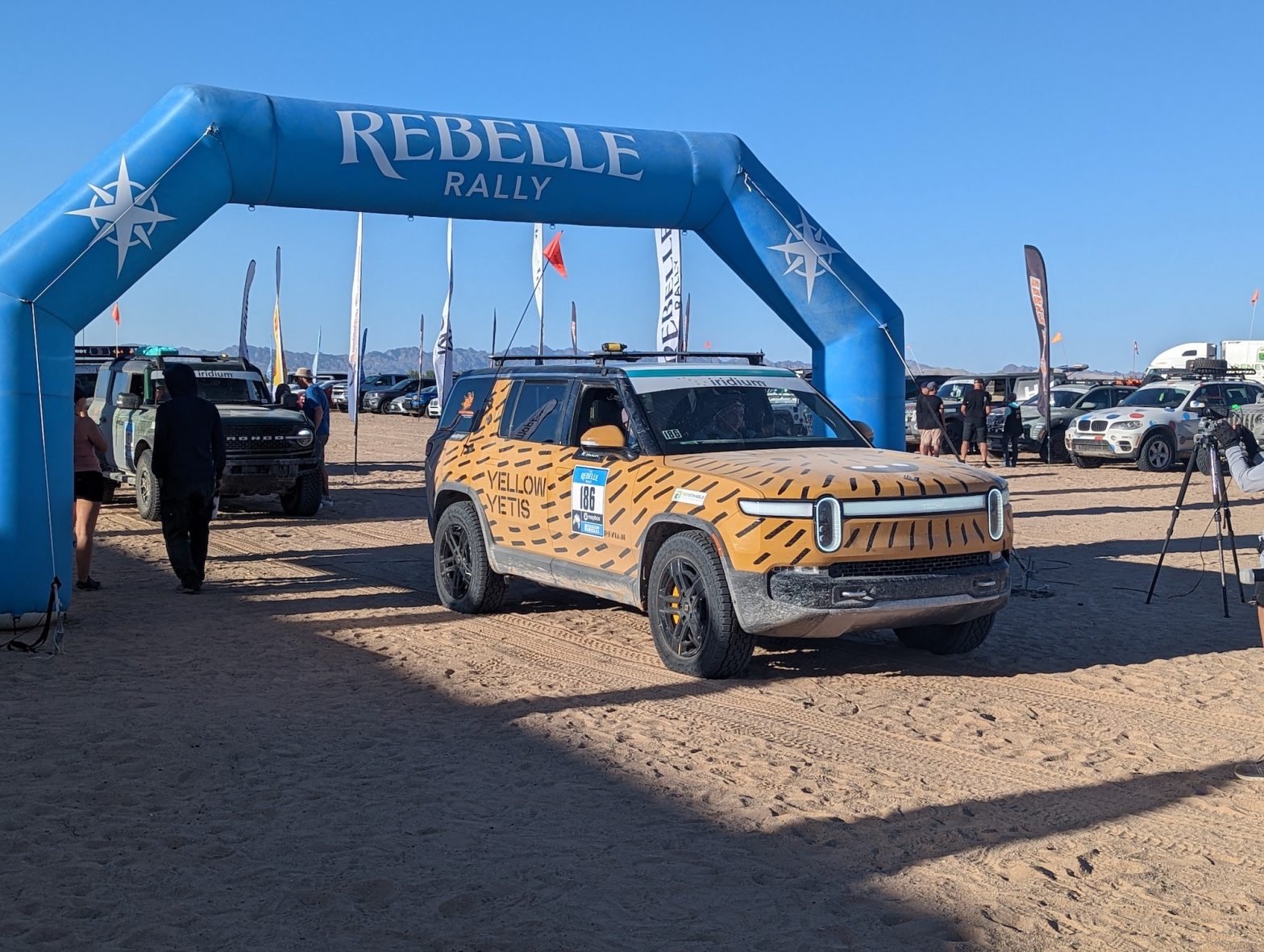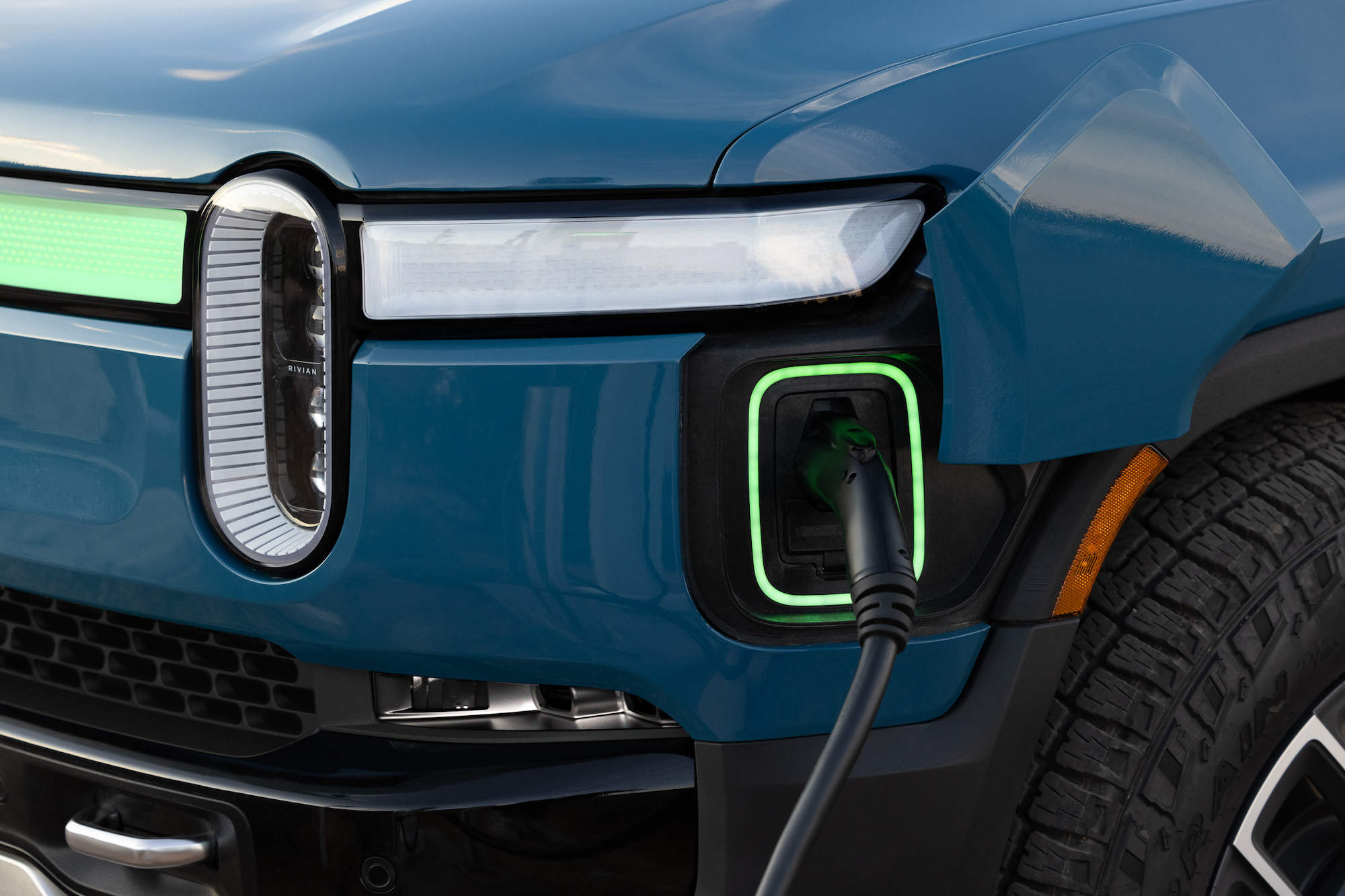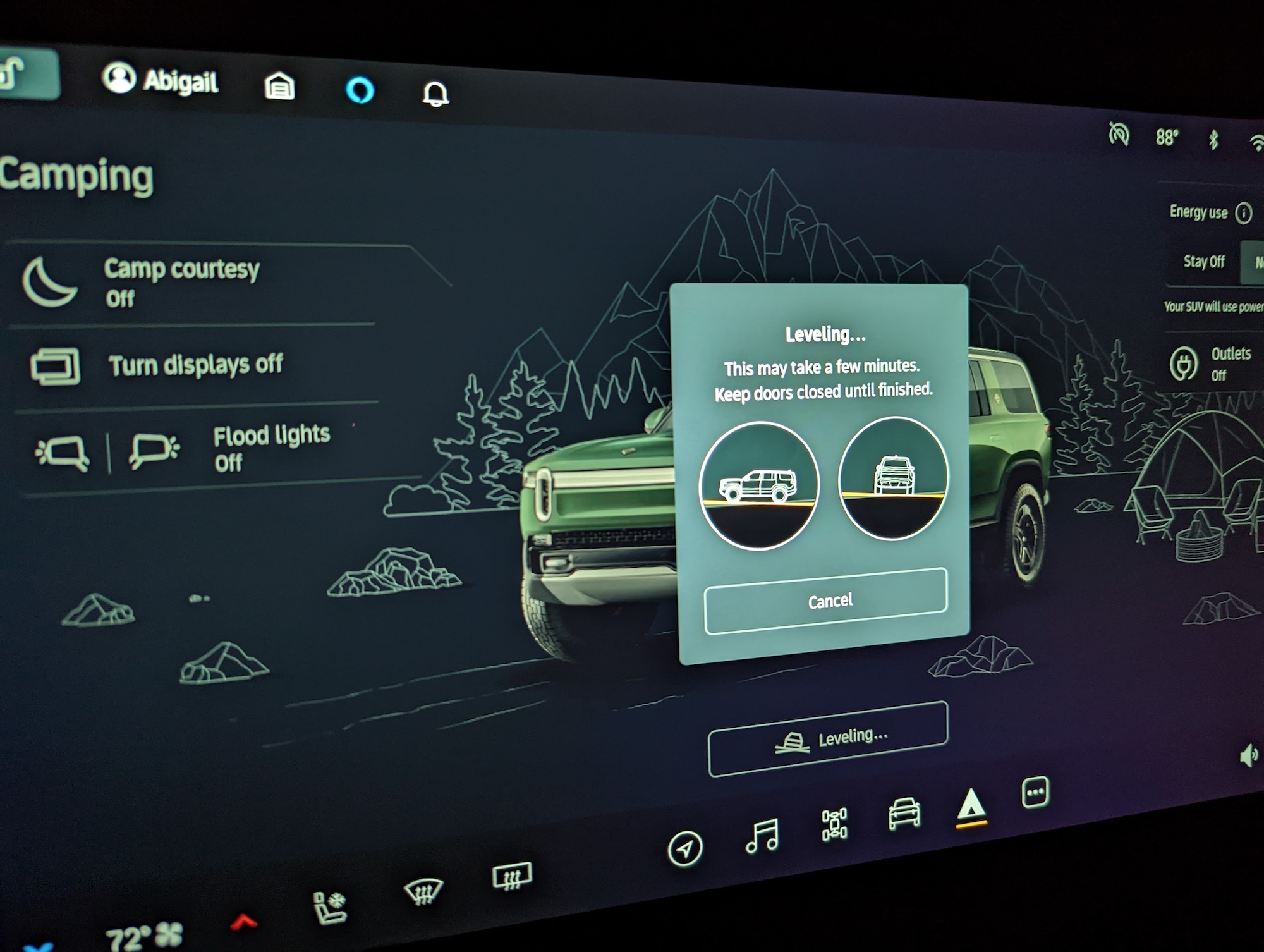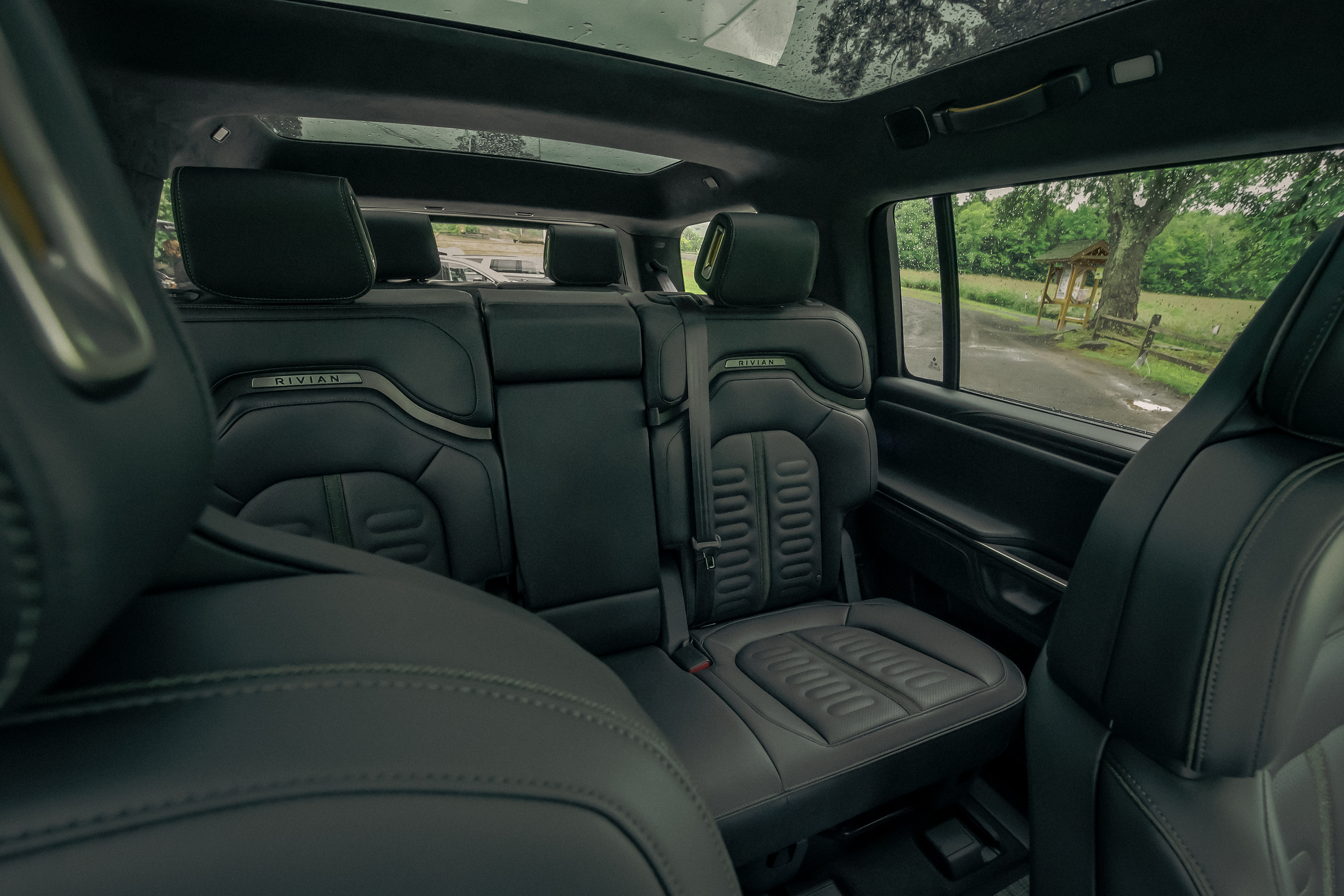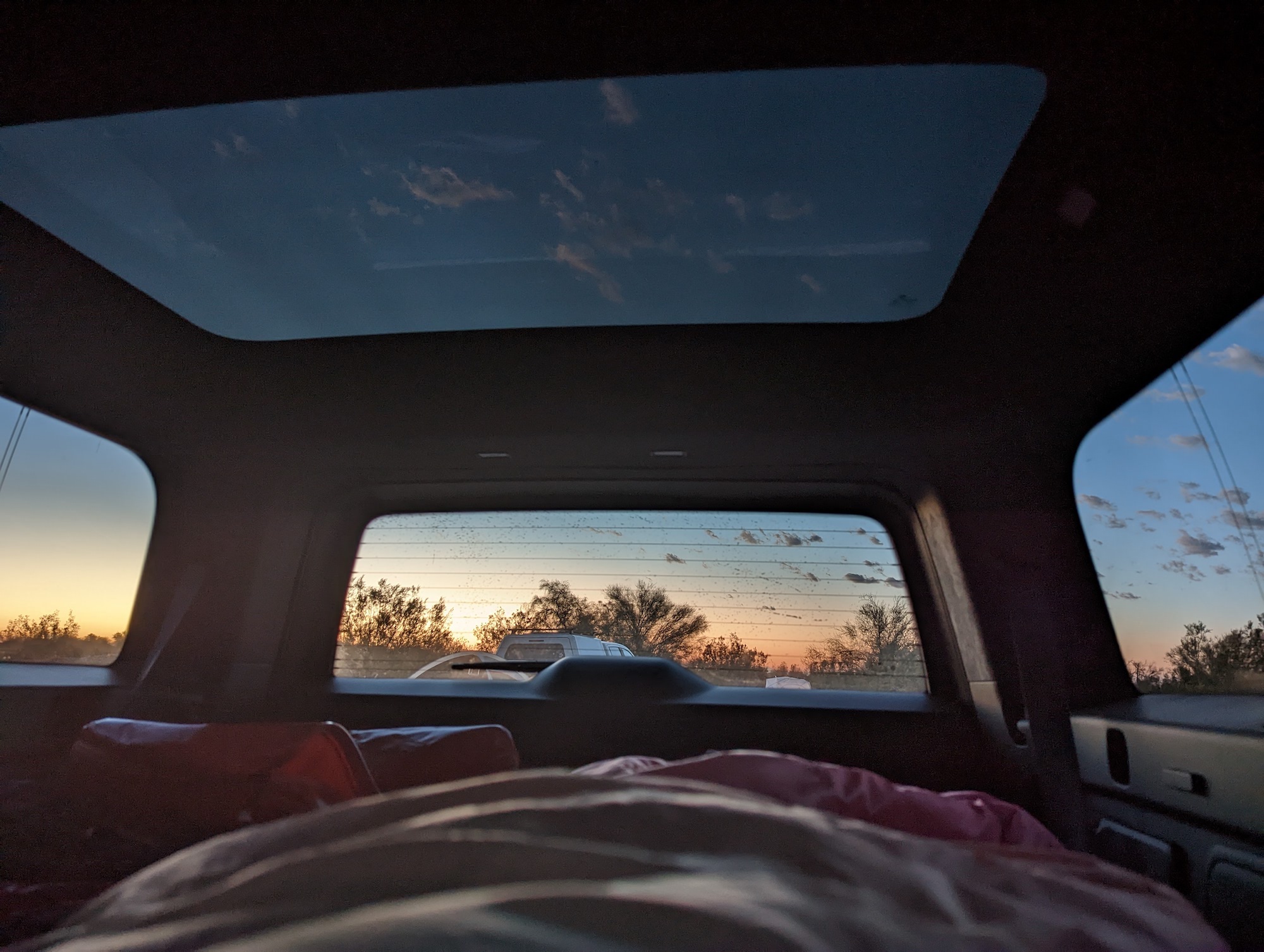Let’s be clear: I hate the desert.
In spite of competing in last year’s Rebelle Rally and spending a full 10-days completely off the grid, camping, competing, navigating and driving offroad in the Nevada and California deserts with 150 other women, I still dislike it. Add in a harrowing 60-mile-per-hour haboob or two, heat that won’t quit, random scorpions in your gear, and little sleep, and I’ve had all the “fun” that a desert can throw at you.
Needless to say, I won’t be the first person to sign up to voluntarily camp in the desert. That is unless we’re talking about getting a chance to test what it’s like roadtripping with, and camping in, the 2023 Rivian R1S.
My adventure began with a 250-mile drive into the heart of the largest sand dune complex in the U.S. to once again cover the Rebelle Rally. In truth, camping was the least of my concerns. Getting stranded in the desert was higher on my list. Even after thousands of miles in EVs, I suffer from a form of range anxiety, thanks to my experience with inflated EV range numbers and other close calls. These estimates, consistent only in their optimism, had me planning for the worst-case scenario.
Unnecessary range anxiety
Since I’d driven the dunes as a competitor in a bone-stock Porsche Cayenne S in the 2021 Rebelle Rally, I had no doubt that the R1S would be absolutely fine in the soft sand. It was getting there and managing any potential battery drain from driving in the dunes that gave me pause.
Luckily, the Rebelle Rally organizers and their partner Renewable Innovations have been at the forefront of figuring out ways to power electric and electrified vehicles competing in the 1,600-mile-long offroad and off-the-grid competition for the last three years. I’d already talked with Emily Miller, the founder of the Rebelle, about charging from the semi-truck-based charger for competitor vehicles if I needed it.
My R1S with the large battery pack and an EPA-estimated 314 miles of range had just under 80% (266 miles according to the R1S) of range remaining when I hit the road.
In truth, the battery lasted longer than I did.
R1S Roadtrip: Comfortable, with some minor issues
The highway route between Los Angeles and Brawley is flat, fast and straight. On the road, the R1S is comfortable and relatively quiet at speeds under 75 miles per hour. At higher speeds, such as when passing, you start to hear quite a bit of wind noise around the side view mirrors.
I did take a slight detour on a winding road. It was here that I could really feel the weight of the 7,000-pound vehicle. While it cornered relatively flat, you really don’t want to push it very hard when the road gets curvy; I should note that no one should expect a large SUV to handle like a sports car.
Setting the advanced driver assistance system, which includes adaptive cruise control and highway assist, is done through the shift stalk on the right side of the steering wheel — which at first takes a little getting used to. Once I got it sorted out, I used the adaptive cruise control on the long, four-lane road heading out toward Brawley, California. Highway assist will brake, steer and accelerate on select highways, but my route along CA-86 and CA-78 wasn’t among that selection, which meant that I used the regular cruise control system on that stretch.
It’s clear Rivian isn’t trying to replicate the experience of driving an ICE vehicle. Regenerative braking defaults to a relatively high setting, meaning that the moment you take your foot off the accelerator, the R1S will start to slow dramatically rather than coast. Frustratingly, when the R1S has a full charge, regen braking is reduced, which means you have to drive differently to compensate.
My biggest complaint is the Alexa-based voice recognition in the R1S (and R1T). As much as I am loath to share more information with big tech, I opted into testing Alexa with the Rivian for the sake of this review and had consistent problems getting the system to do anything beyond recognizing “Alexa,” its wake word, before timing out.
I tried the system both in Glamis, with sparse connectivity, and around the LA area, where connectivity is great. I tried everything from putting in a specific address to asking Alexa to find the closest DC fast charger. More than half the time, the system would get to the point where I asked it to set the destination, and then it wouldn’t do anything more. I tried repeatedly, and it repeatedly failed. It didn’t matter if I was setting my home address or a set of longitude and latitude points in the desert.
Eventually I gave up, pulled over and just manually typed in the address I wanted, because you really can’t (and shouldn’t) mess with the center screen while hurtling along at highway speeds.
Charging along the way
Finding charging stations on the Rivian navigation system isn’t difficult, but you cannot get charger status or availability from your vehicle, at least not right now. Tesla was the first — and remains one of the only automakers — to give drivers information on the availability of its chargers.
From the main infotainment screen, you can find a station that you like, then tap on the charger and the infotainment system will give you directions. On the Rivian app (once you’ve set up your phone as a key), you can plan a route and send it to your vehicle, but the app doesn’t show the status for any chargers, either.
To actually find out which chargers were pumping out 350 kWh, available and not located, say, at the far end of a dark parking lot, I had to use a multitude of apps, including those by Electrify America, EvGo and ChargePoint. While Rivian’s onboard navigation system shows chargers on all networks, it can’t show you the status of those chargers.
Before I headed out on my trip, I also used A Better Route Planner (ABRP), which lets you specify your vehicle, starting state of charge, number of desired charging stops, the remaining battery needed at your arrival point and even preferred charging networks–if you upgrade from the free version.
Because ABRP overlays onto Google Maps, you can also see which stores and restaurants are nearby, so you don’t have to wait in the car while you charge. You’ll still have to cross-reference your chosen chargers with each network’s app to be sure that they are indeed available, working and putting out the power you want, but ABRP offers the most useful information about charging on a road trip.
I settled on an EA station in Palm Desert with available DC Fast chargers located in a Target parking lot. On the map, it appeared there were some restaurants nearby, too. Since it was nearly 100 degrees in Palm Desert, I decided to grab some food at a local Island Burger and watch the R1S charge via Rivian’s app while chowing on a giant salad. By the time I was done, the R1S was fully charged, and I headed back out. The tally? An hour and a half for a full charge (just over 89 kWh, according to the EA charger I plugged into).
I arrived at my campsite roughly five miles off the main road in the dunes of Glamis with 180 miles of range to spare. I parked and got set up to camp in the vehicle for the next three (or so I thought) nights.
Setting up camp in the Imperial sand dunes
After a 250-plus mile drive from my home in Los Angeles in an attention-getting Forest Green Rivian R1S outfitted with blacked-out 20-inch wheels and specially-designed all-terrain Pirelli Scorpion tires, I wasn’t really worried about the vehicle’s capability in the dunes of Glamis. After all, Rivian has been actively competing in the Rebelle Rally with development vehicles for the last three years and has used learnings from the teams and competitors to create things like Sand Mode to help owners (and Rebelles) deal with gnarly offroading situations.
This year, Rivian ran two teams in the Rebelle, made up of four female Rivian employees, and the company will take their experiences, frustrations, and lessons into consideration to create future updates and improvements for owners. In fact, it’s a part of the company’s ethos, and the approach is what has led to innovations like the Camp Kitchen and automatic tonneau cover, which are undergoing redesigns for the R1T pickup truck.
In spite of my special type of range anxiety, I arrived at the final Rebelle basecamp just as the sun was going down, on a Thursday evening, with more than 180 miles of range left.
Once I figured out where to set up, I drove over, parked, and toggled through a few menus to find Camp Mode, a feature Rivian released via an over-the-air-update over Labor Day weekend this year. Camp Mode offers a suite of features and settings that includes vehicle leveling of up to 7.28 inches in each corner, optimized energy use for overnight in-cabin charging and camping, and courtesy lighting and dimming settings for interior and exterior lights as well as the giant 16-inch infotainment screen at the center of the vehicle.
During the leveling process, you have to keep all the doors shut and keep your foot off the brake. Rivian says that the leveling itself can take anywhere from 20 seconds to a few minutes, depending on how uneven the terrain is. In my case, it took just under a minute for the R1S to level out.
Once the vehicle is leveled, you can toggle through a few features, including options for outside flood lights, turn on Camp Courtesy mode, which turns off all exterior lights, sounds, and proximity locking, runs the climate control at a quieter level, and allows you to customize whether you’d like to have the power outlets in the vehicle on or off for a period of time.
You can also set the climate control to run for anywhere from one to 24 hours, depending on your needs. There are three “Energy Use” options to choose from, too: Stay Off, Normal, and Stay On. Stay off is used for when you camp outside your vehicle and want it to sleep. Normal is essentially default power use, which Rivan roughly estimates results in approximately 2-3 miles of range lost per night.
Stay On, according to Rivian keeps power running for both climate and displays and results in a loss of roughly 15-20 miles of range per night. Seeking some balance in the range, I kept it in Normal energy mode, which powered the USB-C outlets so I could charge my phone, kept the air conditioning on since temperatures overnight only dipped to the high 80s, and turned on the power outlet so I could run a white noise machine overnight. If I was going to camp in the desert again, I was determined to do it in comfort.
Sleeping inside the R1S
I pushed the front seats forward and lowered the second and third rows to form a flat-ish floor. The second and third rows fold flat and have a gap between them that I filled with a spare yoga blanket. I also used the adjustable cargo floor board to slightly level out the cargo space, but there was still a two-degree slope towards the tailgate in that section–a feature that Rivian designed to make loading cargo easier, but one that isn’t ideal for sleeping inside the vehicle. In spite of piling some more yoga blankets on the cargo deck, I still ended up scrunched up against the tailgate by the morning.
At 5’7″, I didn’t have any problem sleeping flat in the back. If I were any taller, I would have to reconfigure my sleeping arrangement because my head or feet would dangle off the top of the second-row seats. I had plenty of space for my gear and set up an air mattress, sleeping bag and camp blanket, and a camping pillow on one half of the R1S with my gear on the other.
One of my favorite things about using Camp Mode in the R1S is being able to have constant, low-level climate control and not lose a ton of range overnight. The first night, I set the climate control to 72 degrees, plugged in all my electronics to charge, and after a good 6 hours of sleep, woke up to discover I’d only lost 10 miles of range. The second night, after spending all day in 106-degree heat, I turned the climate control down to 70 degrees and lost 14 additional miles of range.
I also really liked the massive twin glass roofs that stretch from the front to back of the R1S, at least for camping. Being able to look up and gaze at the moon or watch the stars from the comfort of a climate-controlled space makes camping in the desert that much more pleasant. Plus, if there’s another massive sandstorm, there’s no risk of getting sandblasted at 3 am.
The glass roof, however, doesn’t have any physical shade to block out the sun, which does mean that if you’re on a long, hot road trip to the desert and focused on maximizing your range, the air conditioning is weak, especially compared to ICE vehicles. Since the women who competed in the Rally were focused on maximizing their range, they used reflective foam core to block the glass roof in their R1S so they could stay cooler and minimize their climate control use. The team in the R1T ran the whole rally with their windows down to minimize power usage.
At night, out of the blowing sand and raging sun, the front seat of the R1S was a really comfortable place to get some work done, too. The Launch Edition’s WiFi hotspot was simple to use. I sent my editors three stories from the cockpit of the vehicle without a problem.
Those small issues
As much as I hate the desert, the R1S was a surprisingly comfortable place to sleep for two nights. The biggest issues I had with camping in the R1S were tiny but annoying enough to make their mark.
For one, the Rivian key fob, which is designed with an integrated carabiner and almost flat featureless button sections, has no tactile markings on it. It’s fine if you’re locking or unlocking the vehicle during daylight hours, but you can’t use touch to unlock it in the dark of night. I eventually gave up on it and used my phone as the key while camping.
Rivian also provided an NFC key card and bracelet key, which I tried out as well. Neither one was reliable enough for me to forgo my phone as a key. One blazing hot afternoon, I tried to open the R1S with the bracelet, and it took me a full five minutes of hunting around with my wrist pressed to the driver’s side door handle to finally unlock it. It’s not quick or reliable.
I also had a handful of small glitches during my time in the R1S. For example, I rolled down the window in the middle of the night to get some fresh air and just see what the temperature felt like, and it refused to go back up. In spite of it being late, I climbed out, locked and unlocked the vehicle a few times, and tried the window again. It finally went up after a couple of attempts. The same thing happened one night after the folks from Renewable Innovations gave me a charge and left the driver’s window down. After a couple of on-off cycles, it finally went all the way up.
These small glitches aside, Camp Mode in the Rivian R1S certainly changed my perspective on camping in the desert. Doing it in an EV makes so much sense, especially if you’re looking to take in the quiet majesty of a clear sky on a warm night. I’m still not a fan of the desert (it rained bugs on my way home on Saturday), but sleeping in the back of a Rivian R1S is a good way to be comfortable in it.
